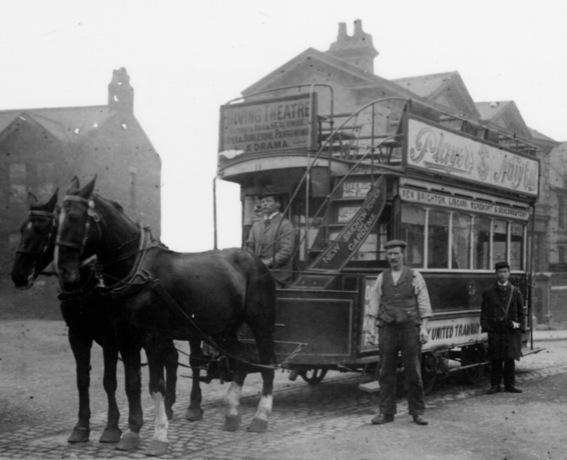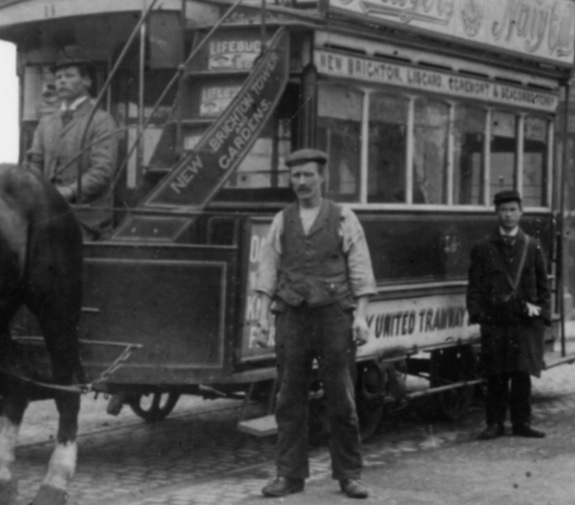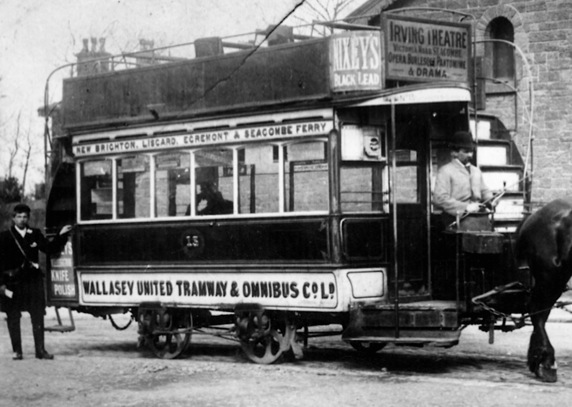Wallasey Horse Tramways
History
Following a number of abortive schemes to build a horse tramway in Wallasey, success was finally achieved by a group of promoters that included William and Daniel Busby of Liverpool, who would together and with others, pioneer the building of numerous horse tramways in the north of England. Having obtained the agreement of the local authority (Wallasey Local Board), powers to build 5.48 miles of tramway were obtained on the 16th August 1878 under the Wallasey Tramways Act (1878), the act also incorporating a company — the Wallasey Tramways Company — to finance, construct and operate the tramway.
The support of Wallasey Local Board had, however, been obtained at some cost, with various clauses having been inserted into the act, including the right to purchase the tramway after 15 years, a rental of £100 per annum, a 50% share of all profits above a certain threshold, and a transfer of ownership (without compensation) should the company fail to run a regular service for a period of three months.
Construction commenced on the 16th December 1878, the line opening to the public just over six months later on the 28th June 1879, though at the Seacombe end, only as far as the junction of Church Road and Fell Street. This was extended along Church Road towards Seacombe Ferry on the 11th September 1879, and again in December 1879 into the ferry terminal itself (Victoria Place), which was privately owned (by Wallasey Local Board) and therefore did not require parliamentary powers. This took the standard-gauge, horse-drawn tramway to its final size of 3.33 miles. From Seacombe Ferry, the line followed Church Road, heading northwards via Brighton Street, and northwestwards to Liscard along Liscard Road; between the latter and Brighton Street, outward cars travelled via Falkland Road, and returning cars via Church Street. From Liscard, where there was another loop — outbound via Manor Street and Queen Street, inbound via Main Road — the line headed northwards along Rake Lane to a terminus in Rowson Street, Upper Brighton, just beyond the latter's junction with Field Road, where the depot was situated.
The company failed to build several sections of tramway for which it had parliamentary authorisation, including the line down to the New Brighton, which was largely due to the objections of the Local Board, who had an effective veto. The unbuilt lines were formally abandoned on the 25th June 1886 via the Wallasey Tramways Act (1886).
The initial services were worked by eight tramcars, which were soon joined by four more, taking the fleet to twelve vehicles. Although the company initially managed to pay reasonable dividends, it would appear that this was only made possible by skimping on track maintenance, a move that was to have serious repercussions. Although the tramway had been built in close collaboration with Wallasey Local Board, the latter had insisted on the use of the Barker Rail — a design that was to prove troublesome for many early tramways — and the company had not only acquiesced (against the advice of its engineer), but had then compounded the error by using the lightweight version of the rail. It wasn't long therefore, before the track started to deteriorate, and with it, not only the company's tramcars, but also their relationship with the Local Board. Each blamed the other, but when it transpired that the tracks had also been poorly laid (i.e., not to the agreed specification), the company ended up footing the bill.
Although several attempts were made in the 1880s to tap into the lucrative summer season day-tripper market, either by extending the tramway from Upper Brighton or building a new line nearer the shore along the newly built Seabank Road, permission was not forthcoming. The unmet demand eventually led to the introduction of omnibuses along Seabank Road (by the Magazines, New Brighton and District Omnibus and Carriage Company), the tramway company initially competing (using its own omnibuses), but then having to withdraw them due to a legal challenge. A separate company — the Seacombe and New Brighton Omnibus Company — was, however, soon set up (in August 1885), with several directors in common with the WTCo, so competition quickly resumed.
Eventually, a new company was set up — the Wallasey United Tramway and Omnibus Company — on the 20th April 1888 to manage all the Busby's transport interests in the area, though the formal merger between the omnibus and the tramway company did not take place until the 8th May 1891.
The tramway and omnibus services were both impacted by the opening of the Seacombe, Hoylake and Deeside Railway Company's line to New Brighton on the 30th March 1888; this line connected to the Mersey Railway Company's line at Birkenhead Park Station, enabling passengers to and from Liverpool to reach New Brighton without using the ferries, tramways or omnibuses. With a downturn in the number of passengers, the tramway company once again allowed maintenance to lapse, having several spats with the Local Board, all of which ended up with it having to spend money. The ease of rail travel did, however, have a silver lining, as it led to dramatic growth in the area during the 1890s, the merged company (the WUT&OCo) responding by improving maintenance of the tracks and buying seven new horsecars (in 1893).
The upturn in the WUT&OCo's fortunes was, however, to prove relatively short lived, as in 1896 the local authority — since 1894 Wallasey Urban District Council — expressed its intention to build a new electric tramway along Seabank Road, which was rightly perceived by the company to be a prelude to the acquisition and conversion of their own system. Although the company was keen to operate electric services (either owned by the company or leased from the UDC), it soon became abundantly clear that the council had no intention whatsoever of letting any company, let alone the WUT&OCo, run an electric tramway within its jurisdiction.
The UDC obtained powers (on the 6th June 1899) to reconstruct the horse tramway for overhead electric traction, build new lines, and operate the system municipally; these were granted under the Wallasey Tramways and Improvements Act (1899). However, rather than sell out to the council, the WUT&OCo chose to fight on, as it believed that the council had forfeited its right to buy the company under the 1878 enabling act (after 15 years had elapsed), and was thus not legally entitled to force through a compulsory purchase. After a long, drawn-out and acrimonious legal battle, which ended up in the House of Lords, the decision went against the company, Wallasey UDC taking over the company's tramway assets on the 1st April 1901.
The council immediately invested in new horses and three second-hand vehicles, operating the tramway very successfully pending its reconstruction for overhead electric working. The last council-operated horse-tram service ran on the 19th March 1902.
Uniforms
Photographs that depict either tramcars or staff of the Wallasey Tramways Company (1879 to 1891) have not survived, so details of the uniforms worn, if any, remain unknown. Several photos do, however, exist from the days of its successor — the Wallasey United Tramway and Omnibus Company — and given that it was created by a merger between the tramway company and an omnibus company, it seems highly probably that the WUT&OCo's policy with respect to uniforms was merely a continuation of the WTCo's.
In common with the majority of horse tramways in the UK, drivers simply wore heavy-duty informal attire — trousers, jackets, knee blankets and the popular headgear of the day, the near ubiquitous bowler hat. Conductors may have worn informal jackets and trousers (this is unclear), along with long overcoats and kepi-style caps (at least in the latter years of operation); the latter would either have been company issued, or a requirement of employment, the men purchasing them from a designated supplier. Although it is difficult to say with any degree of certainty, these caps appear not to have carried any kind of badge.
Photographs of inspectors, which the company are known to have employed, have not survived, so it is unclear whether they wore a uniform or cap.
Further reading
For a history of Wallasey's tramways, see: 'The Tramways of Birkenhead and Wallasey' by T B Maund and M Jenkins; LRTA (1987).
Images
Horse tram drivers and conductors
Wallasey United Tramway, Omnibus Company Car No 10 — stands in Rowson Street at the northern terminus in Upper Brighton. Photo courtesy of the Tramways and Light Railway Society, with thanks to David Voice.
An enlargement of the above photograph clearly showing the conductor's kepi-style cap — apparently worn without insignia of any kind — and the long, single-breasted overcoat.
WUT&OCo Horsecar No 13 at the Upper Brighton terminus opposite Field Road — photo undated, but probably taken in 1901. Photo courtesy of the Tramways and Light Railway Society, with thanks to David Voice.